Also, if anyone ever thinks I'm getting an ID wrong on these critters, by all means, let me know. I think I'm pretty good, but I slip up, and this is one of the few instances in which I'll gladly solicit criticism. I know half of these offhand, and the rest I can usually identify, but wild animals have an annoying habit of refusing to pose beside a field guide or my Google search results.
Day 8: Double-crested cormorant

Double-crested cormorants, Phalacrocorax auritus, in non-breeding plumage.
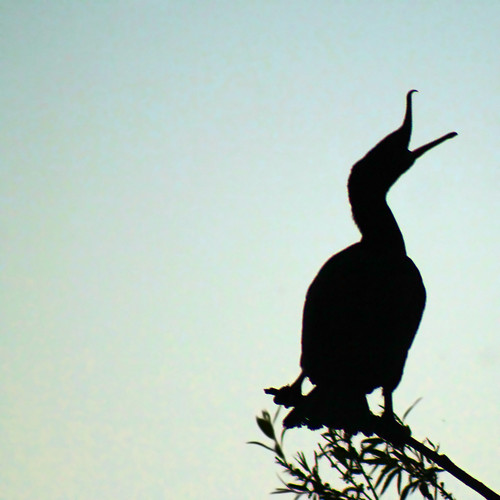 Voracious gulpers of fish and chasers of one another. Distinctive face. How has no one made a cartoon character out of one of these guys?
Voracious gulpers of fish and chasers of one another. Distinctive face. How has no one made a cartoon character out of one of these guys?Seen at water holes all around, but we especially like the ones at the Gilbert Riparian Preserve (they also have neotropic cormorants, but word has it that double-cresteds are more common, and that, along with the bill and tail lengths, cinched it for me, I think). These guys have personality -- cormorality? Whatever. They're hilarious. Instead of chirping or squawking, they have a kind of burping noise that they make at one another. And they make it all the time. If you go toward the back of the preserve on most evenings, you can hear them preparing to roost in some of the large trees; dozens and dozens of them, into the hundreds, maybe. Each time a new cormorant comes to the tree, it steals an already-occupied branch, sending the occupant careening to grab another branch, often another occupied one, and so on. There are usually free branches, but they rarely go for those. They steal and bicker, in an enormous chorus of irritated belches.
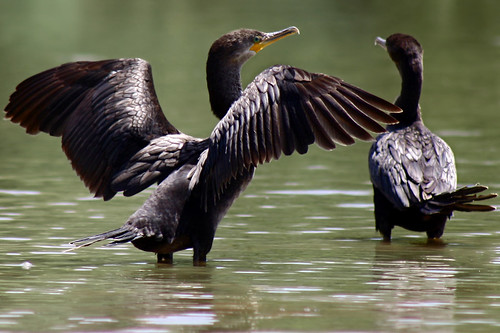
They act kind of the same when they're fishing, or even just standing around. I really kind of dig the perpetually glaring turquoise gaze and that grimace of a bill. (My son and husband theorize it's because I see myself in the derisive glare and constant scolding. To which I say ... Hey! Get off my seat!)
Day 9: Great egret
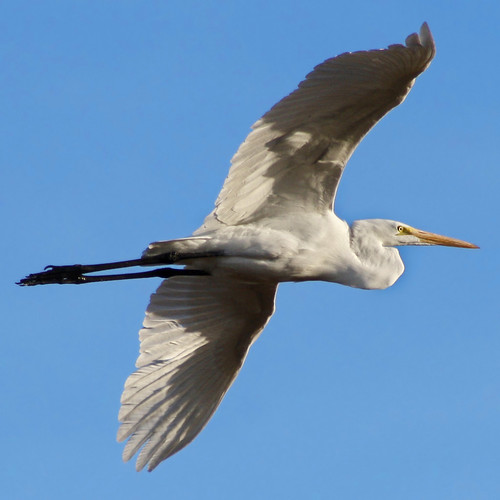
Ardea alba, also known as the Great White Egret, or bird way to gorgeous to make droppings the size of my entire body.

Love these guys. I miss about 95 percent of the shots I attempt, especially when they're flying, mostly because they're more fun to watch. Their expansive white wings and back carve a graceful arch through the air. Their long necks form tucked in S shapes as the sharp bills cut the air. Even their feet -- a little gnarled and scaly close up -- trail pin-straight behind them in a graceful black tail. When they brake to land, the feet pull up and the wings spread, and light bleeds through each overlapping feather, stark-white alternating with gray elliptical accents, like a series of ethereal Venn diagrams.

(It can't all be nature rhapsodizing. I'm still a dork.)
Day 10: Wolf spider (I think)
I'm the spider gal, but I'm not an expert at identifying them all. After all, my favorite spiders are some of the most readily identifiable, and I still run into quandaries.

This one was tough for me, but the eye orientation, legs, and general body structure and size on this one have me thinking it's a wolf spider in the Rabidosa genus. That means "rabid" wolf spider, by the way, and I think it's an apt name for really any wolf spider. I'm not scared of them, mind you. (I know. I'm nuts.) But that doesn't mean, if I have the lens nearly touching the thing and it decides to run for me at Mach 10, that I'm not going to jump back a few feet.
These live in our garage sometimes. Don't tell my husband.
Day 11: House finch
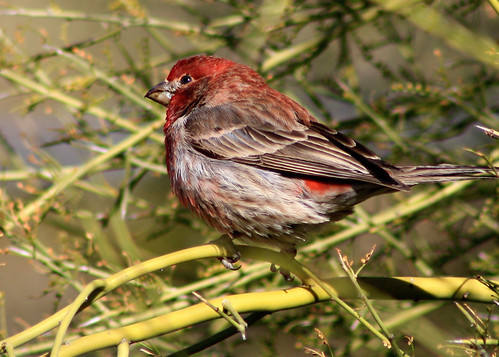
A male house finch, Carpodacus mexicanus, in a paloverde. I really should photograph these guys more often.
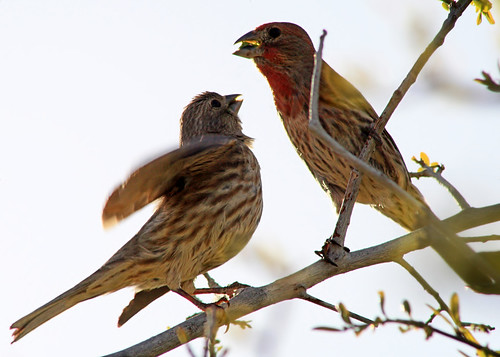
Common. But also gorgeous. House finches started as residents of Mexico and the Southwestern United States, but have been introduced and sold (illegally) throughout the rest of the country over the years. In most cases, they've settled readily, foraging for seeds and grains wherever they happen to be. Whether you lament the species they might have displaced or are happy to see the little guys, you've got to admit, as one online friend put it when I posted the picture: "Everywhere we go, from forest to desert, New England to Arizona, house finches are there. Nesting in eaves, nesting in chollas, nearly always singing ... this bird's got game!"
Day 12: Small milkweed bug
A small milkweed bug, Lygaeus kalmii, on my fingertip. I remember these as some of the first splashes of color I saw in the insects that shared our backyard growing up. I'd seen ladybugs before, and we had a ton of insects (and arachnids) that were variations of brown, gray, and black; but these were so pretty, with their vivid red Xs over the black and gray. I thought they were terribly exotic. For a while, there were black-and-red as well as black-and-orange milkweed bugs that would appear every year for a few weeks on a plant between my house and the bus stop. I would rush to check on them each day. It was one of the first wildlife obsessions I had, and it was just this common little bug. It's funny what inspires us.

I still think they're gorgeous. Specialized too -- the sap of the milkweed plant on which they feed is poisonous and gummy, and can wreak havoc with most things that try to eat it. Milkweed bugs have specialized piercing and sucking mouth parts (if my husband is reading this, you can stop snickering now) that avoid the bad stuff and get the good stuff. They also feed on other nectars, and have been known to forage when food sources are scarce. They lay eggs on milkweed plants in the spring.
Day 13: Anna's hummingbird
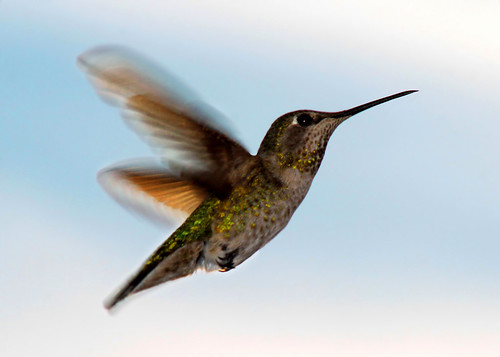
Anna's hummingbirds, Calypte anna, are abundant this time of year. I
 believe we have at least two nests of them in the trees around our backyard, and our hummingbird feeder is perpetually, well, humming. Their bodies are gilded in green with bronze highlights, and the males have flashy red heads.
believe we have at least two nests of them in the trees around our backyard, and our hummingbird feeder is perpetually, well, humming. Their bodies are gilded in green with bronze highlights, and the males have flashy red heads.Anna's are huge nectar feeders, and so are also important pollinators. They supplement their diet with tiny insects, which they somehow snatch out of mid-air with wide-open bills. They're feisty and aggressive -- I'm dive-bombed nearly every time I visit my own backyard -- and they sing, a lot, which is pretty unusual for hummingbirds. Their song is usually a series of raspy squeaks, but they do make a louder noise, which has been said to be produced by the tail feathers. It's during the courtship/territory display the male puts on. When a female enters his territory (which seems to equate to "anything I can see or might possibly feel like claiming"), the male Anna's climbs to almost 100 feet, until he becomes a speck in the sky and almost disappears. Then, he falls. Plummets. At the last second, right beside the female, he veers off wildly and lets out an explosive shriek. It's really something to see. Just try not to unwittingly walk right beneath the display, or 1) you'll have a very angry hummingbird; and 2) you'll look extremely foolish, fearfully shielding yourself from something that is four inches long.

Day 14: Black-necked stilts
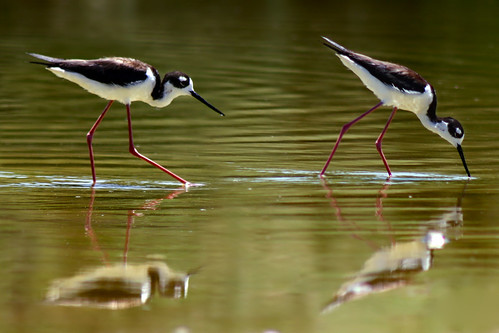
Black-necked stilts, Himantopus mexicanus, are another common sight at the Gilbert Riparian Preserve.
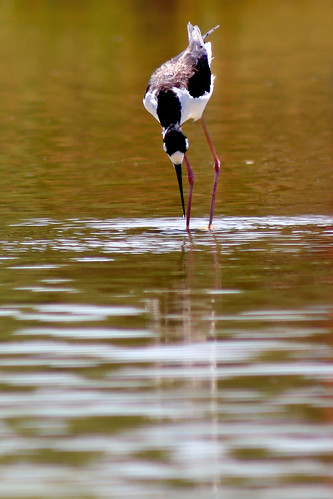 Whenever I see these guys, I can't believe how fragile they look. The spindly pink legs, the thin bill. Even their painted look and the prissy way they walk. They just look to delicate to be allowed. They certainly manage. Though they're hunted by some animals, especially feral cat colonies, their numbers are staying strong for the most part. They're common migrants in Arizona, but they also breed here.
Whenever I see these guys, I can't believe how fragile they look. The spindly pink legs, the thin bill. Even their painted look and the prissy way they walk. They just look to delicate to be allowed. They certainly manage. Though they're hunted by some animals, especially feral cat colonies, their numbers are staying strong for the most part. They're common migrants in Arizona, but they also breed here.I think they do catch small fish from time to time, but mostly, they forage. They stalk daintily through the shallows, scouting the water and mud for tiny invertebrates that I never see until they pluck them up.
Also, they're noisy. Courtship, territorial disputes, annoyance at bird watchers and photographers ... if you can't see any stilts, just listen. They're probably making noise right now.
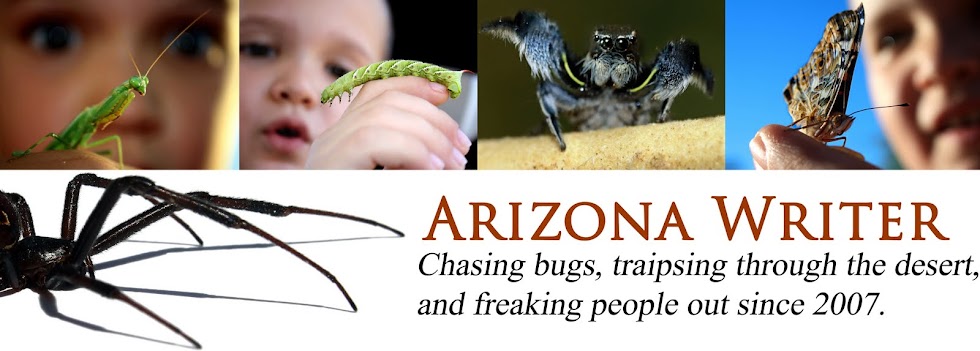
7 comments:
Wow...I am so impressed with this series, you really know your stuff! I love love the hummingbird images and the wolf spider is awesome!
Thanks! Getting close enough is the key -- which, according to most people, means I'm really lucky in the case of the hummingbirds and a bit nuts in the case of the spider.
I am so jealous of your camera equipment! THough as my photographer brother often needles me, it is not just the equipment but also the eye of the photographer that counts :) But, well, hey, it's nearly St. Patrick's Day, so I might as well be green with envy. Beautiful pix. Just beautiful.
Thanks, Christina. I like to think it's at least a little bit me too. Actually, for a DSLR, I have pretty cheap equipment. But I do have good models!
Great pics!
this is seriously impressive, kim!
You have some really beautiful photos here!!
my photography - please take a look?
Post a Comment